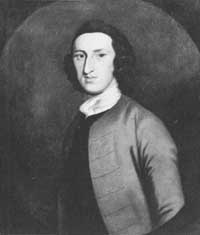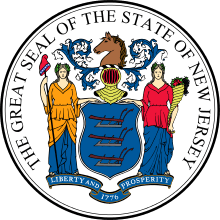William Livingston
| William Livingston | |
|---|---|
 | |
| 1st Governor of New Jersey | |
|
In office August 31, 1776 – July 25, 1790 | |
| Preceded by |
William Franklin as Royal Governor |
| Succeeded by |
Elisha Lawrence Acting Governor |
| Personal details | |
| Born |
November 30, 1723 Albany, New York |
| Died |
July 25, 1790 (aged 66) Elizabeth, New Jersey |
| Resting place | Green-Wood Cemetery, Brooklyn, New York |
William Livingston (November 30, 1723 – July 25, 1790) served as the Governor of New Jersey (1776–1790) during the American Revolutionary War and was a signer of the United States Constitution.
Early life
Livingston was the son of Philip Livingston and was born in Albany. Livingston received his early education from local schools and tutors. At age 14, Livingston was sent to live for a year with an Anglican missionary among the Iroquois Indians in the Mohawk Valley. He enrolled at Yale College upon his return in 1738 and graduated in 1741. He went on to New York City, where he studied law and became a law clerk for James Alexander and William Smith.[1] Livingston married Susannah French in New Jersey in 1745. They went on to have 13 children.[2]
Law, Politics, and the Revolution
He was admitted to the bar in 1748 and began his practice in New York City. In 1752, along with William Smith and John Morin Scott he founded a weekly journal, the Independent Reflector. The Reflector was New York's first serial non-newspaper publication and the only one being published in British North America at the time. It was used as a platform for challenging the powerful De Lancey/Anglican faction, most notably over the founding of King's College. Publication of the Reflector ceased with the fifty-second issue after political pressure was brought to bear upon its printer, James Parker. Livingston served one term in the New York Assembly, but he remained politically active in its affairs until his political allies lost power in 1769.[1]
New Jersey
He moved to Elizabethtown (today Elizabeth, New Jersey) in 1770, where he built a large country home to house his growing family. The house, known as Liberty Hall, still stands today.[1] After attaining considerable influence amongst the local patriots, Livingston was elected to serve as one of New Jersey's delegates to the Continental Congress. He served from July 1774 to June 1776. In October 1775, he was commissioned a brigadier general of the New Jersey Militia.

In August 1776 he was elected Governor of New Jersey and was reelected to the office each year until his death in 1790.[1] For much of the time between 1776 and 1779, the family was located in Parsippany for safety. Liberty Hall was frequently visited by British troops or naval forces since there was a substantial reward for Livingston's capture. The family returned in 1779 to begin restoring their looted home. He was elected a Fellow of the American Academy of Arts and Sciences in 1782.[3]
Later years and death
Livingston led the New Jersey Delegation to the 1787 Constitutional Convention in Philadelphia, Pennsylvania and was one of the signers of the Constitution.[1] Livingston died on July 25, 1790 in Elizabeth, New Jersey, and was originally buried at Trinity Church, Manhattan, but on May 7, 1844 was reinterred at Green-Wood Cemetery, Brooklyn.
Legacy
In 1747, Livingston wrote and published a long pastoral poem entitled, "Philosophic Solitude, or the Choice of a Rural Life". One of the first successful original poems written by an American colonist, it was anthologized numerous times into the 19th century. In 1754, Livingston also played a key role in founding the New York Society Library, which is still in existence over a quarter of a millennium later.
Livingston's daughter Sarah was born in 1756 and was educated at home in penmanship, English grammar, the Bible, and classic literature. At a time when women were usually relegated to the kitchen, she was brought up to be politically aware, even serving at times as her father’s secretary.[4] She married John Jay at the age of 17 and became United States First Lady (age 22) while Jay served as the President of the Continental Congress from 1778–1779. Sarah accompanied John Jay to Spain and then Paris where he, along with John Adams, Benjamin Franklin, and Henry Laurens negotiated the Treaty of Paris. She is credited with writing the celebratory Treaty of Paris dinner toast. When Sarah and John returned to New York, Jay was appointed U.S. Foreign Secretary, and her Parisian training came in handy, as she and her husband established the custom of weekly dinners for the diplomatic corps and other guests in the U.S. capital city of New York. Sarah would go on to serve in her hospitality role as the wife of the first Chief Justice of the United States and First Lady of New York. Livingston's other daughter, Susannah, married John Cleves Symmes in 1780 and became the stepmother-in-law of President William Henry Harrison. Another descendant of William Livingston was Julia Kean, wife of United States Secretary of State and New York Governor Hamilton Fish.
The township of Livingston, New Jersey was given its name in his honor,[5] as was Governor Livingston High School in Berkeley Heights, New Jersey.
The Livingston campus of Rutgers University New Brunswick also was given its name in his honor.
See also
References
- 1 2 3 4 5 Wright, Jr., Robert K. & MacGregor Jr., Morris J. "William Livingston". Soldier-Statesmen of the Constitution. Washington, DC: United States Army Center of Military History. CMH Pub 71-25.
- ↑ "America's Founding Fathers - Delegates to the Constitutional Convention: New Jersey". U.S. National Archives & Records Administration. Archived from the original on June 6, 2016.
- ↑ "Book of Members, 1780–2010: Chapter L" (PDF). American Academy of Arts and Sciences. Retrieved July 28, 2014.
- ↑ About Sarah Livingston Jay. Accessed October 13, 2014.
- ↑ About Livingston. Accessed March 9, 2007.
External links
- United States Congress. "William Livingston (id: L000374)". Biographical Directory of the United States Congress.
- William Livingston in 1911 Britannica
- New Jersey Governor William Livingston, National Governors Association
- "PHILOSOPHIC SOLITUDE" (1747) by William Livingston
- William Livingston at Find a Grave – cenotaph at Trinity Churchyard
- William Livingston at Find a Grave – Green-Wood Cemetery
- Green-Wood Cemetery Burial Search
| Political offices | ||
|---|---|---|
| Preceded by William Franklin Royal Governor |
New Jersey Governor 1776–1790 |
Succeeded by Elisha Lawrence Acting Governor |

